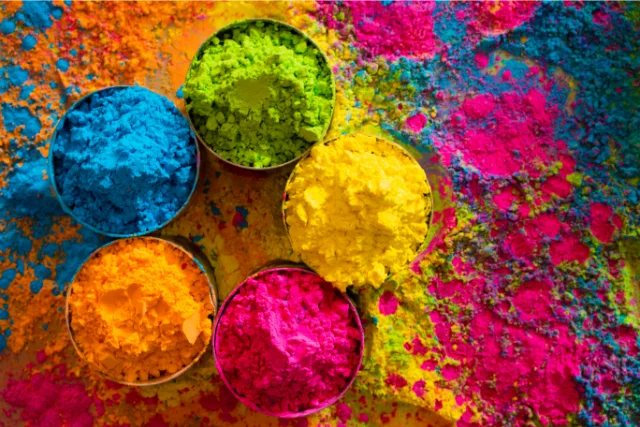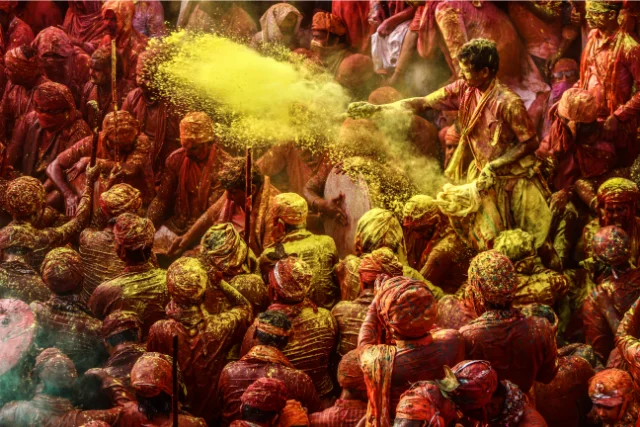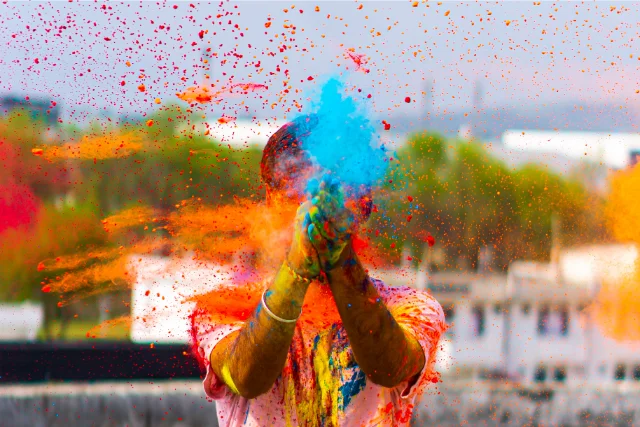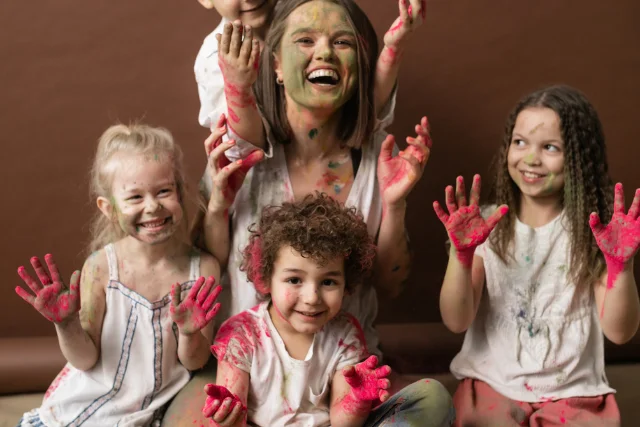As an Amazon Associate, I earn from qualifying purchases. This post may contain affiliate links. If you make a purchase through these links, we may earn a commission at no additional cost to you. Please read our full disclosure here.
In the kaleidoscope of festivals that adorn the cultural landscape of India, few shine as brightly or exude as much vivacity as Holi. Celebrated with unbridled enthusiasm and an explosion of colors, Holi is a festival that encapsulates the essence of spring, renewal, and the triumph of good over evil.
Holi, also known as the Festival of Colors, typically falls in March, marking the end of winter and the arrival of spring. The exact date varies each year according to the Hindu lunar calendar, with festivities spanning over two days in most regions of India. The first day, known as Holika Dahan or Choti Holi, involves the lighting of bonfires to symbolize the victory of virtue over vice. The following day, known as Rangwali Holi, is when the streets come alive with a riot of colors as people joyously drench each other with colored powders and water.
As the world prepares to welcome the season of renewal, let us embark on a journey to explore the vibrant world of Holi, delving into its rich traditions, profound significance, and the diverse ways it is celebrated across the globe.
Understanding Holi: Significance, History, and Cultural Importance
Holi, known as the Festival of Colors, stands as one of the most vibrant and joyous celebrations in India, marking the arrival of spring and the triumph of good over evil. Rooted in Hindu mythology and scriptures, Holi holds deep significance as a time for renewal, unity, and the celebration of life. Its origins can be traced back to ancient legends, with one of the most renowned tales being that of Prahlad and Holika. Prahlad, a devotee of Lord Vishnu, triumphed over the evil Holika with the protection of divine intervention, symbolizing the victory of righteousness over malevolence. This tale, along with various others, serves as the foundation for the rituals and customs observed during Holi.
Beyond its mythological roots, Holi holds immense cultural importance in India, fostering bonds of friendship and community spirit. It is a time when people come together to shed their differences and rejoice in the shared experience of color and laughter. The festival also carries agricultural significance, coinciding with the harvest season and the onset of spring, when fields burst into bloom and nature awakens from its winter slumber.
Throughout history, Holi has evolved into a kaleidoscope of rituals and traditions, each region of India adding its own unique flavor to the festivities. From the vibrant streets of Mathura and Vrindavan, where Holi is celebrated with fervent devotion to Lord Krishna, to the exuberant public gatherings in metropolitan cities like Delhi and Mumbai, Holi manifests in myriad forms across the country. Rituals such as the lighting of bonfires, known as Holika Dahan, and the playful throwing of colored powders and water, exemplify the diverse tapestry of customs that define this beloved festival.
The Traditions and Customs of Holi Celebration
Holi, a festival synonymous with vibrant colors and jubilant festivities, is celebrated with a myriad of cherished traditions and customs that embody the spirit of joy and camaraderie. As the festival heralds the arrival of spring, communities across India and beyond come together to partake in age-old rituals that have been passed down through generations, each adding a unique flavor to the celebration.
Holika Dahan
The festivities kick off with Holika Dahan, a ritualistic bonfire lighting ceremony held on the eve of Holi. Symbolizing the victory of good over evil, this ancient tradition commemorates the tale of Prahlad and Holika from Hindu mythology. Families and communities gather around towering pyres, adorned with effigies of Holika, and offer prayers to Lord Agni, the fire god. As the flames leap skyward, casting a warm glow over the gathering, chants and hymns fill the air, evoking a sense of reverence and awe.
Playing with Colors
The heart of Holi lies in the exuberant play with colors that takes place on Rangwali Holi, the main day of celebration. Armed with packets of gulal (colored powders) and water-filled balloons, revelers take to the streets, squares, and parks, transforming them into kaleidoscopic canvases of joy. Laughter rings out as friends and strangers alike chase one another, smearing each other’s faces with vibrant hues of red, yellow, green, and blue. The playful exchange of colors symbolizes the breaking down of barriers and the fostering of unity and equality, as people of all ages and backgrounds join in the colorful revelry.

Abir and Gulal
Among the various colors used during Holi, abir and gulal hold special significance. Abir, a fine powder made from dried flowers, is traditionally applied to the forehead as a symbol of blessing and goodwill. It is often mixed with water to create a paste that is smeared on the cheeks and hands, enhancing the festive atmosphere. Gulal, on the other hand, is a brightly colored powder derived from natural ingredients such as turmeric, neem, and flowers. Its vibrant hues represent the joy and vitality of spring, infusing the celebration with an extra dose of vibrancy and cheer.
Gujiyas and Thandai
No celebration of Holi is complete without indulging in its delectable culinary delights. Sweet treats like gujiyas, crispy dumplings filled with khoya (sweetened condensed milk) and dried fruits, are a perennial favorite, symbolizing the sweetness of life and the abundance of the harvest season. Thandai, a chilled milk-based beverage infused with aromatic spices like saffron, cardamom, and fennel seeds, offers a refreshing respite from the heat of the day. Prepared with love and shared with friends and family, these traditional delicacies add a flavorful touch to the festive feast.
Music and Dance
Music and dance form an integral part of Holi celebrations, adding rhythm and energy to the festivities. From traditional folk tunes to pulsating beats, the air is alive with the sounds of celebration. Dancers clad in vibrant attire move to the infectious rhythms, their movements mirroring the joyous spirit of the occasion. The dhol (drum) beats resonate through the streets, inspiring spontaneous bursts of dance and revelry as people lose themselves in the euphoria of the moment.
Travel Destinations for Holi
Holi, with its exuberant celebrations and vibrant colors, attracts travelers from far and wide to witness the spectacle of this joyous festival. While Holi is celebrated across India and Nepal with great enthusiasm, there are several destinations that stand out for their unique cultural experiences and festive fervor.
Mathura and Vrindavan, India: Revered as the birthplace and childhood abode of Lord Krishna, these twin cities in Uttar Pradesh host elaborate Holi festivities, featuring traditional songs, dances, and colorful processions.
Barsana and Nandgaon, India: Known for the unique Lathmar Holi, where women playfully beat men with sticks in a joyful reenactment of Krishna’s playful teasing of Radha and her friends.
Jaipur, Rajasthan, India: The Pink City offers a royal twist to Holi celebrations with the grand Royal Holi procession at the City Palace, along with lively street revelries that captivate locals and tourists alike.
Kathmandu, Nepal: In the heart of the Kathmandu Valley, Holi brings together locals and travelers in joyful celebrations, featuring traditional temple ceremonies and lively street parties in Thamel.
These destinations promise unforgettable Holi experiences, blending cultural immersion with the vibrant spirit of the festival.
Holi Celebrations Beyond Traditional Roots
While Holi finds its roots in the vibrant cultural tapestry of India, its colorful spirit has transcended borders, captivating people from diverse backgrounds around the globe. Beyond the traditional celebrations in India, Holi is embraced with enthusiasm and creativity in various countries and regions, each adding its own unique twist to the festivities.
Holi in the USA
In the United States, Holi has gained popularity as a multicultural celebration, embraced by Indian diaspora communities and enthusiasts from all walks of life. Major cities like New York, Los Angeles, and San Francisco host vibrant Holi festivals, featuring live music, dance performances, and, of course, the iconic color throws. These events serve as a melting pot of cultures, bringing together people from different backgrounds to celebrate the spirit of unity and diversity.
Holi in Western Europe
Across Western Europe, Holi is celebrated with growing enthusiasm, reflecting the region’s multicultural fabric and spirit of inclusivity. Cities like London, Paris, and Berlin host colorful Holi events, attracting locals and tourists alike with their vibrant atmosphere and festive ambiance. From community gatherings in parks to organized cultural festivals in urban centers, Holi celebrations in Western Europe offer a blend of traditional rituals and modern interpretations, fostering cross-cultural exchanges and intercultural dialogue.
Unique Customs and Adaptations
While Holi celebrations outside India retain the essence of the festival, they often incorporate unique customs and adaptations influenced by local cultures and traditions. In some communities, eco-friendly color powders are preferred to promote sustainability and environmental consciousness. Others may combine Holi with elements of other cultural celebrations or integrate it into larger multicultural events, showcasing the diversity of the global community.
Multicultural Celebrations
In addition to community-specific events, multicultural celebrations of Holi provide platforms for people of different backgrounds to come together and celebrate shared values of joy, friendship, and inclusivity. These events feature a kaleidoscope of cultural performances, culinary delights, and interactive activities, fostering cross-cultural understanding and appreciation.
As we journeyed through Holi’s traditions, customs, and global impact, we marveled at the festival’s ability to unite cultures with vibrant colors and joyful celebrations. As we bid adieu to another Holi season, let’s carry forward its spirit of unity and festivity. Happy Holi, and may its colorful joy continue to brighten our lives throughout the year!


